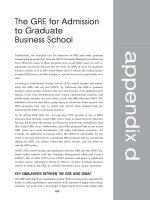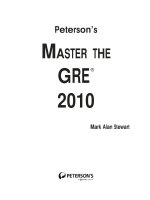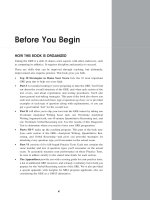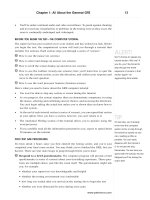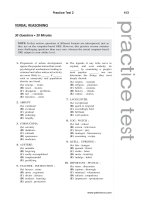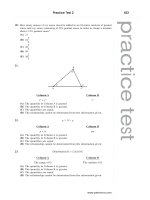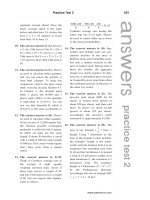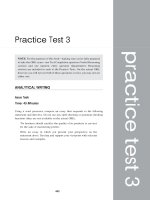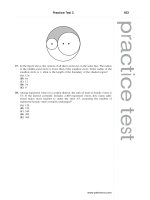Tài liệu Master the Gre 2010 - Part 13 pdf
Bạn đang xem bản rút gọn của tài liệu. Xem và tải ngay bản đầy đủ của tài liệu tại đây (58.71 KB, 10 trang )
Then the writer might indicate how this point actually undermines that position:
However, this behavior only serves to underscore the need for government
intervention, because left unfettered, this type of behavior would only exac-
erbate environmental problems.
TRIVIALIZE A WEAKNESS (OR A STRENGTH)
You can also argue that an apparent weakness in your position (or a strength in a
different position) is trivial, minor, or insignificant. Issue Statement 4 provides a good
opportunity to use this technique. The writer might first cite two examples that lend
apparent support to those who might disagree with the statement:
Detractors might cite the heavy manufacturing and natural resource indus-
tries, where the value of tangible assets—raw materials and capital equip-
ment—are often the most significant determinant of business success.
Then the writer might explain away these examples:
However, such industries are diminishing in significance as we move from
an industrial society to an information age.
APPEAL TO BROADER CONSIDERATIONS
Argue that any minor problems with your position seem trivial in light of the broad
and serious implications that the Issue raises. The notes and outline for Issue
Statement 4 are a good example. The writer might first acknowledge a certain
problem with her position:
Delays typically associated with bureaucratic regulation can thwart the
purpose of the regulations, because environmental problems can quickly
become grave indeed.
Then the writer might point out the broad societal consideration that puts this minor
drawback in its proper perspective:
But such delays seem trivial when we consider that many environmental
problems carry not only a real threat to public health but also a potential
threat to the very survival of the human species.
ADOPT A “LESSER OF TWO EVILS” ARGUMENT
This technique is similar to the previous one; the difference is that you will argue that
an opposing position is no stronger than yours, or is perhaps even weaker in a certain
respect. As with the “broader considerations” technique, the writer might first
acknowledge a certain weakness in her position. Let’s illustrate once again with Issue
Statement 4:
Delays typically associated with bureaucratic regulation can thwart the
purpose of the regulations, because environmental problems can quickly
become grave indeed.
Chapter 4: The Issue Task 103
.................................................................
..............................................................................................
www.petersons.com
But then the writer can point out an even greater weakness in the opposing position:
However, given that unjustifiable reliance on volunteerism is the only alter-
native, government regulation seems necessary.
TRY A “GREATER OF TWO VIRTUES” METHOD
A final avenue of attack is to argue that a particular strength of the opposing position
is overshadowed by one or more virtues of your position. Here’s an Issue Statement
that provides a good opportunity to employ this rhetorical device.
Issue Statement 5
“Large businesses should focus on teamwork as the primary means of achieving
success.”
The writer might first admit that the opposing position has merit:
No reasonable observer of the corporate business world could disagree that
the leadership and vision of a company’s key executives is of great impor-
tance to the organization’s success.
Next, though, the writer would assert that the contrary position has even greater
merit:
Yet chief executives of our most successful corporations would no doubt
admit that without the cooperative efforts of their subordinates, their per-
sonal vision would never become reality.
Put It All Together
Now let’s pull together all of the advanced techniques you’ve just learned by applying
them to the Issue statement about environmental protection from earlier in this
chapter (followed here by a directive):
Issue Statement 4
“The best way to ensure protection and preservation of our natural environment
is through governmental regulatory measures. We cannot rely on the voluntary
efforts of individuals and private businesses to achieve these objectives.”
Present your perspective on the issue above. Use relevant reasons and/or
examples to support your viewpoint.
Here again are our hypothetical test taker’s notes—a list of pros and cons—on Issue
Statement 4. He has now numbered the notes to indicate how he plans to organize his
essay.
PART III: Analytical Writing104
.................................................................
..............................................................................................
www.petersons.com
PRO CON
1
1
• self-interest rules
ind. & bus.
• e.g.
auto emissions
• but
nations too
1
4
• environ. problems too
widespread for
ind. & bus.
• but
nations must
cooperate
1
2
• lawmakers pander
(
• but accountable
to voters
• enforcement problems
• e.g.
bus. relocate
1
3
• bureaucratic problems
• e.g.
delays
• e.g.
compromises
• e.g.
admin. expense
• but
must put up
with problems to
save environ.
Notice that the test taker has decided to begin and end the body of the essay with
“pro” points, possibly because he has weighed the pros and cons and thinks that these
are the strongest arguments. He probably intends to agree, at least on balance, with
the statement. Also notice that he plans to discuss two distinct “cons” in the same
paragraph (2), possibly because he doesn’t have enough to say about them to justify
devoting an entire paragraph to either one alone.
Now here’s a complete essay on Issue Statement 4. It is about 430 words long—a
realistic length for a 45-minute limit. Notice the following features of the essay, which
together boost the essay to the highest score level:
• The essay expresses overall but qualified agreement with the statement, a
thoughtful viewpoint that shows that the writer recognizes the issue’s complexity.
• The body of the essay begins and ends with pro arguments for rhetorical impact.
The con arguments are positioned between them.
• For each of the con arguments (third and fourth paragraphs), the writer immedi-
ately responds with persuasive counterpoints.
Notice also that the writer tried to stick to his outline but also remained flexible as
new ideas for content or organization occurred to him. For example, he repositioned
certain points from the original outline. Additionally, the writer didn’t incorporate
every point from his outline, perhaps because he simply didn’t have time in 30
minutes to cover all of them.
Note that certain words and phrases that you might use in almost any Issue essay are
underlined to help you see how the ideas flow naturally and persuasively from one to
the next. (Remember, though, that the GRE’s built-in word processor does not provide
for underlining.)
Chapter 4: The Issue Task 105
.................................................................
..............................................................................................
www.petersons.com
Essay (Issue Statement 4)
In asserting that government regulation is the “best” way to ensure envi-
ronmental protection, the speaker fails to acknowledge certain problems
inherent with government regulation. Nevertheless, I agree with the
statement to the extent that exclusive reliance on individual or business
volunteerism would be naive and imprudent, especially considering the
stakes involved.
Experience tells us that individuals and private corporations tend to act in
their own short-term economic and political interest, not on behalf of the
environment or the public at large. For example, current technology makes
possible the complete elimination of polluting emissions from automobiles.
Nevertheless, neither automobile manufacturers nor consumers are willing
or able to voluntarily make the short-term sacrifices necessary to accom-
plish this goal. Only the government holds the regulatory and enforcement
power to impose the necessary standards and to ensure that we achieve
these goals.
Admittedly, government penalties do not guarantee compliance with envi-
ronmental regulations. Businesses often attempt to avoid compliance by
concealing their activities, lobbying legislators to modify regulations, or
moving operations to jurisdictions that allow their environmentally harmful
activities. Others calculate the cost of polluting, in terms of punishment,
then budget in advance for anticipated penalties and openly violate the law.
However, this behavior only serves to underscore the need for government
intervention, because left unfettered this type of behavior would only exac-
erbate environmental problems.
One must admit as well that government regulation, environmental or
otherwise, is fraught with bureaucratic and enforcement problems. Regu-
latory systems inherently call for legislative committees, investigations, and
enforcement agencies, all of which add to the tax burden on the citizens
whom these regulations are designed to protect. Also, delays typically asso-
ciated with bureaucratic regulation can thwart the purpose of the regula-
tions, because environmental problems can quickly become grave indeed.
However, given that unjustifiable reliance on volunteerism is the only alter-
native, government regulation seems necessary. Moreover, such delays seem
trivial when we consider that many environmental problems carry not only
a real threat to public health but also a potential threat to the very survival
of the human species.
Finally, environmental issues inherently involve public health and are far
too pandemic in nature for individuals or even businesses to solve on their
own. Many of the most egregious environmental violations traverse state
and sometimes national borders. Individuals and businesses have neither
the power nor the resources to address these widespread hazards.
PART III: Analytical Writing106
.................................................................
..............................................................................................
www.petersons.com
In the final analysis, only the authority and scope of power that a gov-
ernment possesses can ensure the attainment of agreed-upon environ-
mental goals. Since individuals are unable and businesses are by nature
unwilling to assume this responsibility, government must do so.
Structuring Your Essay for Rhetorical Effectiveness
How you arrange your ideas into paragraphs can make a big difference in how
persuasive your final essay is. A basic strategy that works well in most cases is to
start with your best argument and finish with your second-best one, sandwiching your
other arguments (ones for which you see good counterarguments) in between the two.
If you’ve jotted down a two-column list of “pros” and “cons,” like the one you saw a
few pages back, you shouldn’t have any trouble organizing the body of your essay in
this manner. Here’s the basic structure:
1st paragraph: The chief argument (a reason and/or examples) in support of your
position
2nd paragraph: One counterargument, followed by your rebuttal argument
3rd paragraph: Another counterargument, followed by your rebuttal argument
4th paragraph: The second-strongest argument in support of your position
Of course, this isn’t the only effective way to structure an Issue essay. The best
structure is one that allows your ideas to flow most naturally from one to the next.
The following four structural templates cover most situations. (Brackets indicate
optional elements.)
ALTERNATIVE ESSAY STRUCTURE 1
In a case where you have more reasons or examples supporting your position than
against it, try the following structure to acknowledge one strong argument against
your position:
1st paragraph: One reason and/or example supporting your position
2nd paragraph: A second reason and/or example supporting your position
[3rd paragraph: A third reason and/or example supporting your position]
Final paragraph: Chief counterargument » rebuttal
ALTERNATIVE ESSAY STRUCTURE 2
If you have better reasons and/or examples supporting your position than against it,
try this structure to acknowledge one or more strong arguments against your position:
1st paragraph: Chief counterargument
[Next paragraph: A second counterargument]
Next paragraph: One reason and/or example supporting your position
[Next paragraph: A second reason and/or example supporting your position]
Chapter 4: The Issue Task 107
.................................................................
..............................................................................................
NOTE
You don’t have to adhere
strictly to one of these
structures to write an effective
Issue essay. Remember to stay
flexible. The ideas you’ve
jotted down might come
together best in some other
less conventional format—and
that’s just fine if it works well. In
short, let your ideas drive your
essay’s structure, not vice
versa.
www.petersons.com
